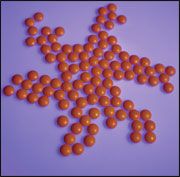Publication
Article
Pharmacy Times
Coagulation Counseling
Author(s):
Dr. Garrett is manager of the Health Education Center at Mission Hospitals in Asheville, North Carolina.
Laxatives May Interfere with Warfarin

Excessive use of stimulant laxatives,such as senna, may interfere withwarfarin therapy. A case was recentlyreported of a patient whoused excessive senna. Thepatient presented withbloody stools and an internationalnormalized ratio(INR) of 11.9. The interactionmay be due to diarrhea,which can developif laxatives are overused.Diarrhea is known to decrease theabsorption of vitamin K, which can leadto elevated INRs and bleeding. Patientsshould be counseled touse herbal laxatives withcare. Natural products thatare promoted for weightloss and detoxification maycontain ingredients such asaloe, cascara, or Europeanbuckthorn, all of whichhave laxative properties.
Alteplase Effective for Stroke up to 4.5 Hours Afterthe Event
Intravenous thrombolysis with alteplaseis the only approved treatment for acuteischemic stroke, but its efficacy andsafety when administered > 3 hours afterthe onset of symptoms have not beenestablished. A recent study of patientswith ischemic stroke, confirmed bycomputed tomography showed a benefitof the drug when given beyond thetypical 3-hour limit. Researchers studieda total of 821 patients given alteplase orplacebo 3 to 4.5 hours after the onset ofstroke symptoms. The major end pointstudied was disability at 90 days.
The median time for the administrationof alteplase was 3 hours 59 minutes.More patients had a favorableoutcome with alteplase (52.4%) thanwith placebo (45.2%). The incidenceof intracranial hemorrhage was higherwith alteplase. Mortality did not differbetween the groups. The authors concludedthat alteplase may offer significantbenefit to patients beyond the timethat is specified by the manufacturer;however, further study is needed.
Protein C and S Deficiency Increase TE Risk
Protein C, protein S, and antithrombindeficiencies are associated withincreased risk of thromboembolism (TE).Dutch researchers recently conducteda retrospective study of 552 subjectsrepresenting 84 families to determine ifa history of venous TE predisposed thesubjects to arterial TE (ATE). Detailedinformation on previous venous TE, ATE,anticoagulant use, and atherosclerosisrisk factors was collected.
Of 552 subjects, 35% had protein S,39% had protein C, and 26% had antithrombindeficiency. Overall, annual incidencesof ATE were 0.34% in deficientsubjects versus 0.17% in nondeficientsubjects; the hazard ratio was 2.3. Afteradjusting for atherosclerosis risk factorsand clustering within families, deficientsubjects had a 4.7-fold higher risk for ATEbefore 55 years of age versus 1.1 thereafter,compared with nondeficient familymembers. For separate deficiencies, therisks were 4.6-, 6.9-, and 1.1-fold higher inprotein S?, protein C?, and antithrombindeficientsubjects, respectively, before 55years of age. History of venous TE wasnot related to subsequent ATE.
The researchers concluded that subjectswith protein S or protein C deficiency,but not antithrombin deficiency,have a higher risk for ATE before 55years of age that is independent of priorvenous TE.
Cigarette SmokingDecreases PlateletAggregation

Researchers have discovered that cigarettesmoking is an independent predictorof the level of platelet aggregation apatient exhibits. This finding may helpexplain the variability in response toclopidogrel therapy. Cigarette smokinginduces the CYP1A2 isoenzyme of thecytochrome P450 system and enhancesthe antiplatelet effect of clopidogrel,researchers reported in a recent issueof the Journal of the American Collegeof Cardiology.
Earlier work in this area of studyshowed that responders to clopidogreltherapy were more often smokers. Thecurrent paper expands on that initialobservation and demonstrates how anexternal factor, smoking, can influenceplatelet reactivity in patients treatedwith a prodrug that is metabolized bythe hepatic cytochrome P450 pathway.The researchers studied 104 currentsmokers and155 nonsmokerswho wereundergoingelective coronarystenting.They wereeither alreadyon clopidogrelor received a600-mg loadingdose. Currentsmokerson chronic clopidogrel showed significantlygreater platelet inhibition andsignificantly lower platelet aggregationthan their nonsmoking counterparts.This also was true of smokers whoreceived the loading dose, comparedwith nonsmokers who received theloading dose. Smoking was a highlysignificant independent predictor of lowplatelet aggregation.







